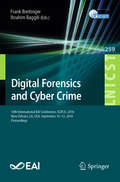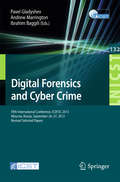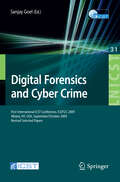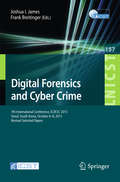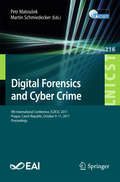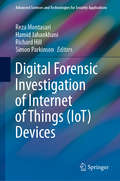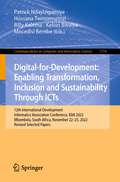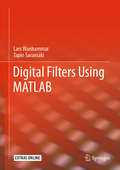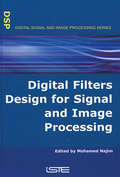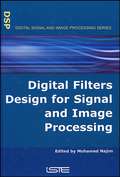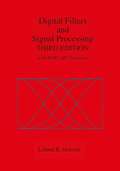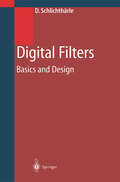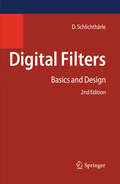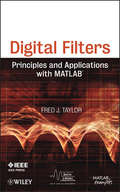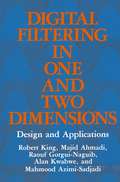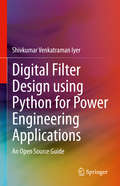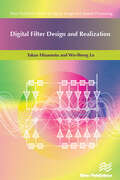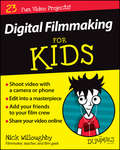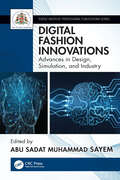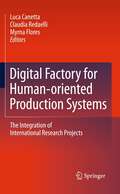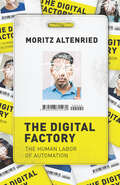- Table View
- List View
Digital Forensics and Cyber Crime: 10th International EAI Conference, ICDF2C 2018, New Orleans, LA, USA, September 10–12, 2018, Proceedings (Lecture Notes of the Institute for Computer Sciences, Social Informatics and Telecommunications Engineering #259)
by Frank Breitinger Ibrahim BaggiliThis book constitutes the refereed proceedings of the 10th International Conference on Digital Forensics and Cyber Crime, ICDF2C 2018, held in New Orleans, LA, USA, in September 2018. The 11 reviewed full papers and 1 short paper were selected from 33 submissions and are grouped in topical sections on carving and data hiding, android, forensic readiness, hard drives and digital forensics, artefact correlation.
Digital Forensics and Cyber Crime: Fifth International Conference, ICDF2C 2013, Moscow, Russia, September 26-27, 2013, Revised Selected Papers (Lecture Notes of the Institute for Computer Sciences, Social Informatics and Telecommunications Engineering #132)
by Pavel Gladyshev Andrew Marrington Ibrahim BaggiliThis book constitutes the thoroughly refereed post-conference proceedings of the 5th International ICST Conference on Digital Forensics and Cyber Crime, ICDF2C 2013, held in September 2013 in Moscow, Russia. The 16 revised full papers presented together with 2 extended abstracts and 1 poster paper were carefully reviewed and selected from 38 submissions. The papers cover diverse topics in the field of digital forensics and cybercrime, ranging from regulation of social networks to file carving, as well as technical issues, information warfare, cyber terrorism, critical infrastructure protection, standards, certification, accreditation, automation and digital forensics in the cloud.
Digital Forensics and Cyber Crime: First International ICST Conference, ICDF2C 2009, Albany, Ny, USA, September 30 - October 2, 2009, Revised Selected Papers (Lecture Notes of the Institute for Computer Sciences, Social Informatics and Telecommunications Engineering #31)
by Sanjay GoelThe First International Conference on Digital Forensics and Cyber Crime (ICDF2C) was held in Albany from September 30 to October 2, 2009. The field of digital for- sics is growing rapidly with implications for several fields including law enforcement, network security, disaster recovery and accounting. This is a multidisciplinary area that requires expertise in several areas including, law, computer science, finance, networking, data mining, and criminal justice. This conference brought together pr- titioners and researchers from diverse fields providing opportunities for business and intellectual engagement among attendees. All the conference sessions were very well attended with vigorous discussions and strong audience interest. The conference featured an excellent program comprising high-quality paper pr- entations and invited speakers from all around the world. The first day featured a plenary session including George Philip, President of University at Albany, Harry Corbit, Suprintendent of New York State Police, and William Pelgrin, Director of New York State Office of Cyber Security and Critical Infrastructure Coordination. An outstanding keynote was provided by Miklos Vasarhelyi on continuous auditing. This was followed by two parallel sessions on accounting fraud /financial crime, and m- timedia and handheld forensics. The second day of the conference featured a mesm- izing keynote talk by Nitesh Dhanjani from Ernst and Young that focused on psyc- logical profiling based on open source intelligence from social network analysis. The third day of the conference featured both basic and advanced tutorials on open source forensics.
Digital Forensics and Cyber Crime: 7th International Conference, ICDF2C 2015, Seoul, South Korea, October 6-8, 2015. Revised Selected Papers (Lecture Notes of the Institute for Computer Sciences, Social Informatics and Telecommunications Engineering #157)
by Joshua I. James Frank BreitingerThis book constitutes the refereed proceedings of the 7th International Conference on Digital Forensics and Cyber Crime, ICDF2C 2015, held in Seoul, South Korea, in October 2015. The 14 papers and 3 abstracts were selected from 40 submissions and cover diverse topics ranging from tactics of cyber crime investigations to digital forensic education, network forensics, and international cooperation in digital investigations.
Digital Forensics and Cyber Crime: 9th International Conference, ICDF2C 2017, Prague, Czech Republic, October 9-11, 2017, Proceedings (Lecture Notes of the Institute for Computer Sciences, Social Informatics and Telecommunications Engineering #216)
by Petr Matoušek Martin SchmiedeckerThis book constitutes the refereed proceedings of the 9th International Conference on Digital Forensics and Cyber Crime, ICDF2C 2017, held in Prague, Czech Republic, in October 2017. The 18 full papers were selected from 50 submissions and are grouped in topical sections on malware and botnet, deanonymization, digital forensics tools, cybercrime investigation and digital forensics triage, digital forensics tools testing and validation, hacking
Digital Forensic Investigation of Internet of Things (Advanced Sciences and Technologies for Security Applications)
by Reza Montasari Hamid Jahankhani Richard Hill Simon ParkinsonThis book provides a valuable reference for digital forensics practitioners and cyber security experts operating in various fields of law enforcement, incident response and commerce. It is also aimed at researchers seeking to obtain a more profound knowledge of Digital Forensics and Cybercrime. Furthermore, the book is an exceptional advanced text for PhD and Master degree programmes in Digital Forensics and Cyber Security. Each chapter of this book is written by an internationally-renowned expert who has extensive experience in law enforcement, industry and academia. The increasing popularity in the use of IoT devices for criminal activities means that there is a maturing discipline and industry around IoT forensics. As technology becomes cheaper and easier to deploy in an increased number of discrete, everyday objects, scope for the automated creation of personalised digital footprints becomes greater. Devices which are presently included within the Internet of Things (IoT) umbrella have a massive potential to enable and shape the way that humans interact and achieve objectives. These also forge a trail of data that can be used to triangulate and identify individuals and their actions. As such, interest and developments in autonomous vehicles, unmanned drones and ‘smart’ home appliances are creating unprecedented opportunities for the research communities to investigate the production and evaluation of evidence through the discipline of digital forensics.
Digital-for-Development: 12th International Development Informatics Association Conference, IDIA 2022, Mbombela, South Africa, November 22–25, 2022, Revised Selected Papers (Communications in Computer and Information Science #1774)
by Patrick Ndayizigamiye Hossana Twinomurinzi Billy Kalema Kelvin Bwalya Mncedisi BembeThis book constitutes the refereed proceedings of the 12th International Development Informatics Association Conference, IDIA 2022, held in Mbombela, South Africa, in November 2022. The 20 revised full papers presented in this volume were carefully reviewed and selected from 61 submissions. The papers are organized in topical sections on theories and practices in digital-for-development ecosystems; emerging technologies for transformation, inclusion and sustainable development; privacy and security in digital-for-development ecosystems; human-computer interaction (HCI) for digital inclusion; artificial intelligence (AI) for good.
Digital Filters Using MATLAB
by Lars Wanhammar Tapio SaramäkiThis textbook provides comprehensive coverage for courses in the basics of design and implementation of digital filters. The book assumes only basic knowledge in digital signal processing and covers state-of-the-art methods for digital filter design and provides a simple route for the readers to design their own filters. The advanced mathematics that is required for the filter design is minimized by providing an extensive MATLAB toolbox with over 300 files. The book presents over 200 design examples with MATLAB code and over 300 problems to be solved by the reader. The students can design and modify the code for their use. The book and the design examples cover almost all known design methods of frequency-selective digital filters as well as some of the authors’ own, unique techniques.
Digital Filters Design for Signal and Image Processing (Digital Signal And Image Processing Ser.)
by Mohamed NajimDealing with digital filtering methods for 1-D and 2-D signals, this book provides the theoretical background in signal processing, covering topics such as the z-transform, Shannon sampling theorem and fast Fourier transform. An entire chapter is devoted to the design of time-continuous filters which provides a useful preliminary step for analog-to-digital filter conversion. Attention is also given to the main methods of designing finite impulse response (FIR) and infinite impulse response (IIR) filters. Bi-dimensional digital filtering (image filtering) is investigated and a study on stability analysis, a very useful tool when implementing IIR filters, is also carried out. As such, it will provide a practical and useful guide to those engaged in signal processing.
Digital Filters Design for Signal and Image Processing
by Mohamed NajimDealing with digital filtering methods for 1-D and 2-D signals, this book provides the theoretical background in signal processing, covering topics such as the z-transform, Shannon sampling theorem and fast Fourier transform. An entire chapter is devoted to the design of time-continuous filters which provides a useful preliminary step for analog-to-digital filter conversion. Attention is also given to the main methods of designing finite impulse response (FIR) and infinite impulse response (IIR) filters. Bi-dimensional digital filtering (image filtering) is investigated and a study on stability analysis, a very useful tool when implementing IIR filters, is also carried out. As such, it will provide a practical and useful guide to those engaged in signal processing.
Digital Filters and Signal Processing: With MATLAB® Exercises
by Leland B. JacksonDigital Filters and Signal Processing, Third Edition ... with MATLAB Exercises presents a general survey of digital signal processing concepts, design methods, and implementation considerations, with an emphasis on digital filters. It is suitable as a textbook for senior undergraduate or first-year graduate courses in digital signal processing. While mathematically rigorous, the book stresses an intuitive understanding of digital filters and signal processing systems, with numerous realistic and relevant examples. Hence, practicing engineers and scientists will also find the book to be a most useful reference. The Third Edition contains a substantial amount of new material including, in particular, the addition of MATLAB exercises to deepen the students' understanding of basic DSP principles and increase their proficiency in the application of these principles. The use of the exercises is not mandatory, but is highly recommended. Other new features include: normalized frequency utilized in the DTFT, e.g., X(ejomega); new computer generated drawings and MATLAB plots throughout the book; Chapter 6 on sampling the DTFT has been completely rewritten; expanded coverage of Types I-IV linear-phase FIR filters; new material on power and doubly-complementary filters; new section on quadrature-mirror filters and their application in filter banks; new section on the design of maximally-flat FIR filters; new section on roundoff-noise reduction using error feedback; and many new problems added throughout.
Digital Filters: Basics and Design
by Dietrich SchlichthärleThis textbook provides an insight into the characteristics and design of digital filters. It includes tables of filter parameters for Butterworth, Chbeyshev, Cauer and Bessel filters and several computer routines for filter design programs.
Digital Filters: Basics and Design
by Dietrich SchlichthärleThe second, strongly enlarged edition of the textbook gives a substantial insight into the characteristics and the design of digital filters. It briefly introduces to the theory of continuous-time systems and the design methods for analog filters. Time-discrete systems, the basic structures of digital filters, sampling theorem, and the design of IIR filters are widely discussed. The author devotes important parts to the design of non-recursive filters and the effects of finite register length. The explanation of techniques like oversampling and noise shaping conclude the book. The author has substantially updated all chapters and added some important topics like Allpass filters. With an emphasize put on the practical implementation of theoretical concepts, the book is a reference for advanced students as well as practicing engineers.
Digital Filters: Principles and Applications with MATLAB (IEEE Series on Digital & Mobile Communication #30)
by Fred TaylorThe book is not an exposition on digital signal processing (DSP) but rather a treatise on digital filters. The material and coverage is comprehensive, presented in a consistent that first develops topics and subtopics in terms it their purpose, relationship to other core ideas, theoretical and conceptual framework, and finally instruction in the implementation of digital filter devices. Each major study is supported by Matlab-enabled activities and examples, with each Chapter culminating in a comprehensive design case study.
Digital Filters: Principles and Applications with MATLAB (IEEE Series on Digital & Mobile Communication #30)
by Fred TaylorThe book is not an exposition on digital signal processing (DSP) but rather a treatise on digital filters. The material and coverage is comprehensive, presented in a consistent that first develops topics and subtopics in terms it their purpose, relationship to other core ideas, theoretical and conceptual framework, and finally instruction in the implementation of digital filter devices. Each major study is supported by Matlab-enabled activities and examples, with each Chapter culminating in a comprehensive design case study.
Digital Filtering in One and Two Dimensions: Design and Applications
by M. Ahmadi M. Azimi-Sadjadi R. Gorgui-Naguib R. King A. KwabweThis book has been conceived to extend the generally published work on one- and two-dimensional digital filters in order to include some of the more recently developed ideas. It is intended to supplement and build on the classical books which cover the fundamental concepts of the topic. As a consequence of this, the basic theory is stated in a compact manner and is not developed thoroughly, as this would result in considerable duplication of existing books. The main theme of the book has been to provide a comprehensive background to the methods available for the realization of both recursive and nonrecursive digital filters, and to give an insight into some of the more recent implementation procedures. The book is planned to cover one- and two-dimensional systems in parallel, showing the techniques which are applicable in both areas, and also the limitations and constraints necessary when a one-dimensional technique is extended to systems of higher dimensionality. The theme of the book commences with several chapters on the design of filter transfer functions to meet given specifications. This is followed by a discussion of methods of implementing these in a practical system and the limitations imposed as a result of noise and finite word length. Finally, a discussion of some applications is included.
Digital Filter Design using Python for Power Engineering Applications: An Open Source Guide
by Shivkumar Venkatraman IyerThis book is an in-depth description on how to design digital filters. The presentation is geared for practicing engineers, using open source computational tools, while incorporating fundamental signal processing theory. The author includes theory as-needed, with an emphasis on translating to practical application. The book describes tools in detail that can be used for filter design, along with the steps needed to automate the entire process.Breaks down signal processing theory into simple, understandable language for practicing engineers;Provides readers with a highly-practical introduction to digital filter design;Uses open source computational tools, while incorporating fundamental signal processing theory;Describes examples of digital systems in engineering and a description of how they are implemented in practice;Includes case studies where filter design is described in depth from inception to final implementation.
Digital Filter Design and Realization
by Takao Hinamoto Wu-Sheng LuAnalysis, design, and realization of digital filters have experienced major developments since the 1970s, and have now become an integral part of the theory and practice in the field of contemporary digital signal processing. Digital Filter Design and Realization is written to present an up-to-date and comprehensive account of the analysis, design, and realization of digital filters. It is intended to be used as a text for graduate students as well as a reference book for practitioners in the field. Prerequisites for this book include basic knowledge of calculus, linear algebra, signal analysis, and linear system theory. Technical topics discussed in the book include:Discrete-Time Systems and z-TransformationStability and Coefficient SensitivityState-Space ModelsFIR Digital Filter DesignFrequency-Domain Digital Filter DesignTime-Domain Digital Filter DesignInterpolated and Frequency-Response-Masking FIR Digital Filter DesignComposite Digital Filter DesignFinite Word Length EffectsCoefficient Sensitivity Analysis and MinimizationError Spectrum ShapingRoundoff Noise Analysis and MinimizationGeneralized Transposed Direct-Form IIBlock-State Realization
Digital Filter Design and Realization
by Takao Hinamoto Wu-Sheng LuAnalysis, design, and realization of digital filters have experienced major developments since the 1970s, and have now become an integral part of the theory and practice in the field of contemporary digital signal processing. Digital Filter Design and Realization is written to present an up-to-date and comprehensive account of the analysis, design, and realization of digital filters. It is intended to be used as a text for graduate students as well as a reference book for practitioners in the field. Prerequisites for this book include basic knowledge of calculus, linear algebra, signal analysis, and linear system theory. Technical topics discussed in the book include:Discrete-Time Systems and z-TransformationStability and Coefficient SensitivityState-Space ModelsFIR Digital Filter DesignFrequency-Domain Digital Filter DesignTime-Domain Digital Filter DesignInterpolated and Frequency-Response-Masking FIR Digital Filter DesignComposite Digital Filter DesignFinite Word Length EffectsCoefficient Sensitivity Analysis and MinimizationError Spectrum ShapingRoundoff Noise Analysis and MinimizationGeneralized Transposed Direct-Form IIBlock-State Realization
Digital Filmmaking For Kids For Dummies (For Kids For Dummies)
by Nick WilloughbyThe easy way for kids to get started with filmmaking If you've been bitten by the filmmaking bug—even if you don't have a background in video or access to fancy equipment—Digital Filmmaking For Kids makes it easy to get up and running with digital filmmaking! This fun and friendly guide walks you through a ton of cool projects that introduce you to all stages of filmmaking. Packed with full-color photos, easy-to-follow instruction, and simple examples, it shows you how to write a script, create a storyboard, pick a set, light a scene, master top-quality sound, frame and shoot, edit, add special effects, and share your finished product with friends or a global audience. Anyone can take a selfie or upload a silly video to YouTube—but it takes practice and skill to shoot professional-looking frames and make your own short film. Written by a film and video professional who has taught hundreds of students, this kid-accessible guide provides you with hands-on projects that make it fun to learn all aspects of video production, from planning to scripting to filming to editing. Plus, it includes access to videos that highlight and demonstrate skills covered in the book, making learning even easier and less intimidating to grasp. Create a film using the tools at hand Plan, script, light and shoot your video Edit and share your film Plan a video project from start to finish If you're a student aged 7–16 with an interest in creating and sharing your self-made video, this friendly guide lights the way for your start in digital filmmaking.
Digital Filmmaking For Kids For Dummies (For Kids For Dummies)
by Nick WilloughbyThe easy way for kids to get started with filmmaking If you've been bitten by the filmmaking bug—even if you don't have a background in video or access to fancy equipment—Digital Filmmaking For Kids makes it easy to get up and running with digital filmmaking! This fun and friendly guide walks you through a ton of cool projects that introduce you to all stages of filmmaking. Packed with full-color photos, easy-to-follow instruction, and simple examples, it shows you how to write a script, create a storyboard, pick a set, light a scene, master top-quality sound, frame and shoot, edit, add special effects, and share your finished product with friends or a global audience. Anyone can take a selfie or upload a silly video to YouTube—but it takes practice and skill to shoot professional-looking frames and make your own short film. Written by a film and video professional who has taught hundreds of students, this kid-accessible guide provides you with hands-on projects that make it fun to learn all aspects of video production, from planning to scripting to filming to editing. Plus, it includes access to videos that highlight and demonstrate skills covered in the book, making learning even easier and less intimidating to grasp. Create a film using the tools at hand Plan, script, light and shoot your video Edit and share your film Plan a video project from start to finish If you're a student aged 7–16 with an interest in creating and sharing your self-made video, this friendly guide lights the way for your start in digital filmmaking.
Digital Fashion Innovations: Advances in Design, Simulation, and Industry (Textile Institute Professional Publications)
by Abu Sadat Muhammad SayemDigitalisation is becoming a standard practice in the fashion industry. Innovation in digital fashion is not just limited to computer-aided design (CAD) and manufacturing (CAM), rather it runs throughout the fashion supply chain, from product life cycle management and developing new business models that promote sustainability to connecting virtual and augmenting reality (VR/AR) with fashion for enhanced consumers experience through smart solutions. Digital Fashion Innovations: Advances in Design, Simulation, and Industry captures the state-of-art developments taking place in this multi-disciplinary field: Discusses digital fashion design and e-prototyping, including 2D/3D CAD, digital pattern cutting, virtual drape simulation and fit analysis. Covers digital human modelling and VR/AR technology. Details digital fashion business and promotion, including application of e-tools for supply chain, e-commerce, block chain technologies, big data, and artificial intelligence (AI). This interdisciplinary book will appeal to professionals working in textile and fashion technology, those developing AR and AI for clothing end uses, and anyone interested in the business of digital fashion and textile design. It will also be of interest to scientists and engineers working in anthropometry for a variety of disciplines, such as medical devices and ergonomics.
Digital Fashion Innovations: Advances in Design, Simulation, and Industry (Textile Institute Professional Publications)
by Abu Sadat Muhammad SayemDigitalisation is becoming a standard practice in the fashion industry. Innovation in digital fashion is not just limited to computer-aided design (CAD) and manufacturing (CAM), rather it runs throughout the fashion supply chain, from product life cycle management and developing new business models that promote sustainability to connecting virtual and augmenting reality (VR/AR) with fashion for enhanced consumers experience through smart solutions. Digital Fashion Innovations: Advances in Design, Simulation, and Industry captures the state-of-art developments taking place in this multi-disciplinary field: Discusses digital fashion design and e-prototyping, including 2D/3D CAD, digital pattern cutting, virtual drape simulation and fit analysis. Covers digital human modelling and VR/AR technology. Details digital fashion business and promotion, including application of e-tools for supply chain, e-commerce, block chain technologies, big data, and artificial intelligence (AI). This interdisciplinary book will appeal to professionals working in textile and fashion technology, those developing AR and AI for clothing end uses, and anyone interested in the business of digital fashion and textile design. It will also be of interest to scientists and engineers working in anthropometry for a variety of disciplines, such as medical devices and ergonomics.
Digital Factory for Human-oriented Production Systems: The Integration of International Research Projects
by Luca Canetta, Claudia Redaelli and Myrna FloresDigital factory is a comprehensive approach providing methodologies, models and tools that support manufacturing enterprises in the rearrangement of their organizational structures to deal with expected changes in manufacturing processes and markets.Digital Factory for Human-oriented Production Systems investigates the impact of the digital factory through a consideration of the entire product/process lifecycle, and the broad network of product engineering, material and component suppliers, manufacturing equipment suppliers, and customers involved in current and next generation manufacturing. It covers the utilization and integration of:human body ergonomics models;production system discrete event simulation;3D/virtual and augmented reality visualization;collaborative design tools;automatic data capture; andknowledge management systems based on semantic web ontologies integrated by a continuous data management.The coverage of various types of factory and manufacturing phases, representations and simulations allows researchers in academia and industry to perform a dynamic analysis and up-to-date modeling of the processes involved. Digital Factory for Human-oriented Production Systems describes the tools that allow a move towards the integrated digital factory and underlines the business impact that companies can obtain by adopting these tools. As well as benefiting international organizations, the proposed methodologies and technologies have also been developed in order to facilitate their adoption by small or medium-sized businesses, making them relevant to all product engineers and managers who want improve the efficiency and effectiveness of their enterprises.
The Digital Factory: The Human Labor of Automation
by Moritz AltenriedThe Digital Factory reveals the hidden human labor that supports today’s digital capitalism. The workers of today’s digital factory include those in Amazon warehouses, delivery drivers, Chinese gaming workers, Filipino content moderators, and rural American search engine optimizers. Repetitive yet stressful, boring yet often emotionally demanding, these jobs require little formal qualification, but can demand a large degree of skills and knowledge. This work is often hidden behind the supposed magic of algorithms and thought to be automated, but it is in fact highly dependent on human labor. The workers of today’s digital factory are not as far removed from a typical auto assembly line as we might think. Moritz Altenried takes us inside today’s digital factories, showing that they take very different forms, including gig economy platforms, video games, and Amazon warehouses. As Altenried shows, these digital factories often share surprising similarities with factories from the industrial age. As globalized capitalism and digital technology continue to transform labor around the world, Altenried offers a timely and poignant exploration of how these changes are restructuring the social division of labor and its geographies as well as the stratifications and lines of struggle.
